Abstract
The current stage of sports development, at the organizational level, seeks to create or maintain a significant number of special training units for children and juniors: school sports clubs, junior sections of the sports clubs, classes with physical education program in middle schools and high schools, national Olympic centres for junior training and, not least, private clubs. Presently, in Romania, it can be noted an increase in the number of sports clubs with basketball activity, which actually does not mean an increase in performance. In this study, there are analysed, in a quantitative perspective, the contributions of sports clubs with basketball activity to the national teams’ performances achieved in the last five years, following their participation in European competitions. There are examined official data regarding the number of sports clubs affiliated to FRB (Romanian Basketball Federation), the number of counties where the teams ranked on the first four places at the final tournaments in the 2011-2014 period and the number of athletes selected from each county to participate in the European Basketball Championships between 2010 and 2014.The collected information provides a diagram illustrating the spread of sports clubs and their performances at junior level in Romania.
Keywords: Performance, basketball, system
Introduction
Performance sport is the model towards which all efforts of the factors engaged in the training
activity of children and junior teams should be directed. Current concerns of the sports movement in
training children and juniors are permanently focused on organizing effective training and guidance at
this age level.
At the organizational level, the goal is to create or maintain a high number of special training units
for children and youth: school sports clubs, junior sections of the sports clubs, classes with physical
education program in middle schools and high schools, national Olympic centres for junior training
and, not least, private clubs.
The selection actions within teams and groups have become permanent, seeking especially the
promotion of young talents (Ghițescu & Moanță, 2008: 169).
Romania’s sports representation in international competitions depends on the performances of
sports clubs affiliated to the specialized federations.
National sports federations have responsibilities in organizing and coordinating the entire activity of
domestic and international competitions (Legea nr. 69/2000).
Sports clubs can be private or public legal entities affiliated to the specialized federations, their role
being to manage and organize activities in one or more sports, which involves training and
participation in competitions.
Currently, in Romania, it can be noted an increase in the number of sports clubs with basketball
activity, which actually does not mean an increase in performance.
In this study, there are analysed, in a quantitative perspective, the contributions of sports clubs with
basketball activity to the national teams’ performances achieved in the last five years, following their
participation in European competitions.
Experts have identified a number of issues affecting the practice of performance sports, out of which
the following have a major impact:
Population access to performance sports; Reduced physical activity due to increased obesity; Lack of interest in practicing performance sports; Dropping out of sports activity around the age of 14-16 years.
The purpose of this study is to identify, within the structural system with basketball activity, the
counties that capitalize experience at the performance level, the tradition and professionalism of all
those involved in practicing performance sports.
Materials and methods
Analysis of the interest in obtaining performance in basketball, but especially of the achieved
results, takes into account the information categories relating, on the one hand, to the sports structure in
which basketball is practiced, and on the other hand, to the achieved performances.
In this regard, there were analysed the following indicators:
The number of sports structures affiliated to FRB (Romanian Basketball Federation), by county; The number of counties where the teams ranked on the first four places at the junior final
tournaments - U16, U18, U20 - from 2011 to 2014;
The number of athletes selected from each county to participate in the European Basketball Championship - U16, U18, U20 - from 2010 to 2014.
Players’ affiliation was established considering their birth place, on the grounds that the sports
structure in the respective county had operated the selection and initial training of players.
This paper contributes, through the data provided, to support the strategy in sports field, highlighting
the need for an increased number of sports structures (economic dimension) for the 2013-2030 period.
Under the current circumstances, in which there is a remarkable increase in the number of sports
structures in the field of basketball, we believe that an analysis of their value using national and
international results may lay the basis for institutional development and performance.
Results
The information used in this study is public and was provided by the FRB and FIBA websites.
Regarding the number of structures affiliated to FRB, it can be stated that, in 2014, there were
affiliated 259 permanent structures in 36 counties and Bucharest Municipality. The situation
concerning the number of sports clubs in each county and Bucharest Municipality is the following
(Table 1):
On the first three places, there are two counties and Bucharest Municipality, which are mentioned in
documents as the first places where basketball was practiced, and we refer here to Bucharest
Municipality and the capital cities of two counties, namely Cluj Napoca and Targu Mures.
In these counties, the weight of practicing basketball game is different by gender, an aspect that will
be discussed in a future study. Regarding the national performances of basketball clubs, these were
analysed in the light of their qualification for the final junior tournaments between 2010 and 2014; all
data were provided by the FRB website, but only the first four places were taken into account. The
situation by county, for both male and female genders, is the following (Table 2):
Out of the 20 counties ranking on the first four places at the final tournaments, male and female,
only 6 had good performances in both men and women: Bucharest, Brasov, Cluj Napoca, Galati,
Prahova and Timis.
The clubs’ entire activity is reflected in the promotion of athletes to national teams, as the best
players on their positions.
Regarding the selection of players to junior national teams - U16, U18, U20, all data were provided
by the FIBA website.
Considering the last five editions of the Junior European Championships in the 2010-2014 period,
and specifying that all male teams participated in competitions in group B and female teams played in
group A (U18 and U20), the situation is as follows (Table 3):
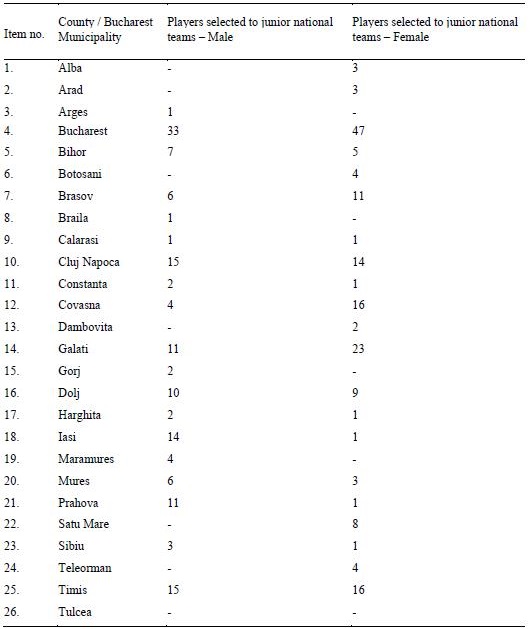
A separate analysis concerning the results at the final tournaments of national championships and
the representativeness of national teams regarding men’s basketball indicates 21 counties that provide
players to national teams, of which 21 ranking on the first four places at the junior final tournaments
(Table 4).
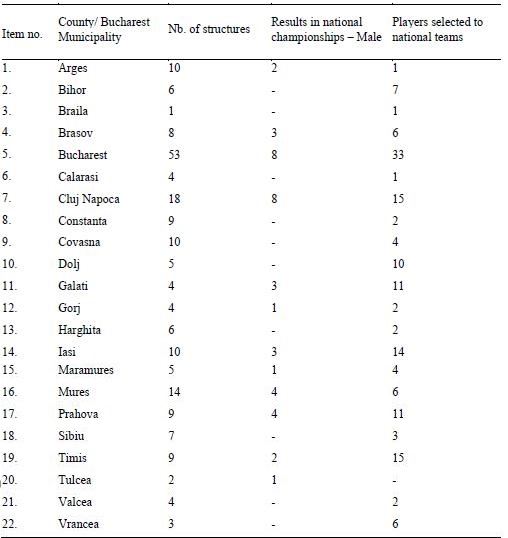
Graphical representation shows the top 5 male values recorded, considering the results in national
championships and the number of players in national teams, which indicate that only 9 counties
correspond to the purposes of this study (Fig. 1).
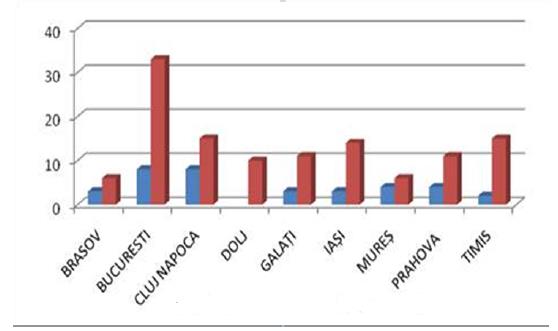
A separate analysis concerning the results at the final tournaments of national championships and
the representativeness of national teams regarding women’s basketball indicates 22 counties that
provide players to national teams, of which 14 ranking on the first four places at the junior final
tournaments (Table 5).
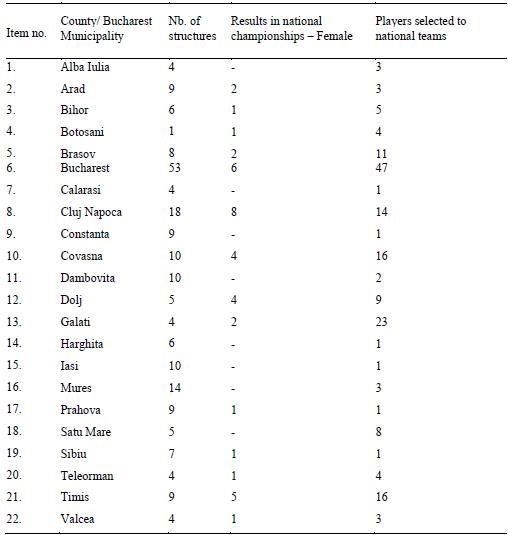
Graphical representation shows the top 5 female values recorded, considering the results in national
championships and the number of players in national teams, which indicate that only 7 counties
correspond to the purposes of this study (Fig. 2).
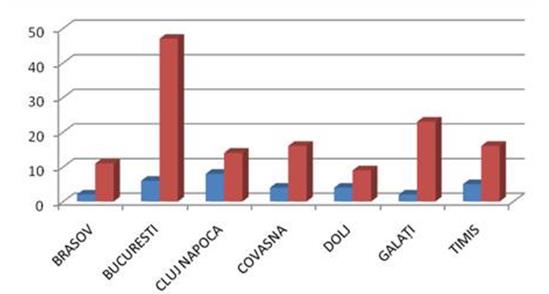
Discussions and conclusions
After conducting the study and performing the analyses, we can highlight that:
Basketball game is practiced within clubs in 37 of the 42 counties (88%), indicating the spread of basketball in Romania;
Considering the affiliated structures, it is noted the continuous interest of the “historical” regions in practicing basketball;
The interest in practicing basketball is different by gender and only 6 counties correspond to the purposes of this study.
9 counties for males and 7 counties for females recorded the highest score, taking into account the performance criteria established in this study: ranking on the first four places at the final tournaments
of national championships and the number of players in national junior teams between 2010 and 2014;
Given the above, we can notice an uneven spread of the basketball game, highlighting the traditional basketball centres and the counties with low or absent basketball activity.
References
FIBA website. Retreived from http://www.fiba.com/ FRB website. Retreived from http://www.frbaschet.ro/ Ghiţescu, I. G., & Moanţă, A. D. (2008). Bazele jocului de baschet. Bucureşti: Matrixrom.
Legea nr. 69/2000. Legea educației fizice și sportului. Retrieved from http://www.dreptonline.ro/legislatie/legea_sportului.php
Copyright information

This work is licensed under a Creative Commons Attribution-NonCommercial-NoDerivatives 4.0 International License.
About this article
Publication Date
10 June 2016
Article Doi
eBook ISBN
978-1-80296-010-5
Publisher
Future Academy
Volume
11
Print ISBN (optional)
-
Edition Number
1st Edition
Pages
1-509
Subjects
Sports, sport science, physical education
Cite this article as:
Moanța, A. D., & Ghițescu, I. G. (2016). Analysis of the Romanian Basketball Sports Club Performance. In V. Grigore, M. Stanescu, & M. Paunescu (Eds.), Physical Education, Sport and Kinetotherapy - ICPESK 2015, vol 11. European Proceedings of Social and Behavioural Sciences (pp. 143-150). Future Academy. https://doi.org/10.15405/epsbs.2016.06.20

